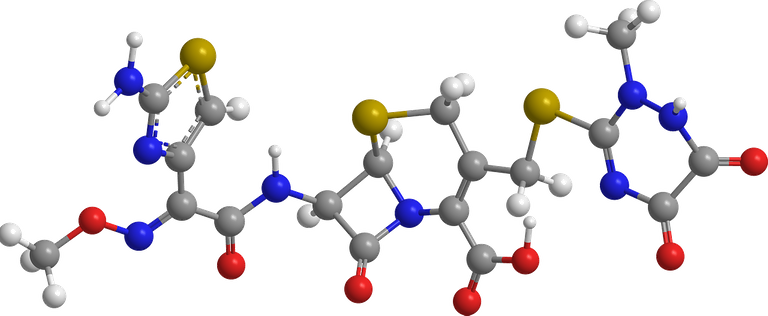Pharmacology - Discussing Cephalosporins, Carbapems, and Monobactams
Today, still on pharmacology, we will be continuing with another Beta Lactam drug, and this time we will be discussing Cephalosporins. So let's begin without wasting any time.
Cephalosporin is another type of Beta-Lactam drug that contains the Beta-lactam rings that are available in Penicillin, a dihydro thiazine ring, and an acetyl side chain. This drug has a fungal origin but there are also semi-synthetic forms now available. Similar to Penicillin they are bactericidal as they attack cell wall synthesis, inhibiting the cell walls of bacteria. Also, they have the same resistance mode as Penicillin. Cephalosporin although similar to penicillin, they have some pathogens that they do not act upon such as Chlamydia, mycoplasma, Enterococci, and Listeria.
Moving to Pharmacokinetics, it is important to know that Cephalosporin drugs are water soluble and are actively secreted in the kidney tubules except for ceftriaxone and cefoperazone which are lipid soluble and are excreted via the liver. The secretion can be blocked by probenecid if it competes. Ceftriaxone and cefoperazone have a very high plasma protein binding which prevents the drug from crossing the blood-brain barrier.
Cephalosporin has five generations which are the first generation, second generation, third generation, fourth generation, and fifth generation. For easy understanding, Drugs of the **First Generation would have the "Pha" "Fa" and "Phra" in their names except for Cefaclor which is a second-generation cephalosporin. In the first generation, drugs include Cefaxolin, Cephalexin, and Cephradine. These drugs do not cross the blood-brain barrier. In the second generation, cephalosporin alongside Cefaclor include Cefuroxime and Cefotetan. Third-generation cephalosporin has "time", "one", "ten", and "ir" in their names but there is an exception which is cefuroxime which is a second-generation cephalosporin. Third-generation drugs include Ceftriaxone, Cefotaxime, Cefixime, Cefdinir, and Ceftibuten. These drugs can cross the blood-brain barrier. Fourth-generation cephalosporin contains "pi" in their names. An example is Cefipine. The fifth-generation cephalosporine has "ine" in their names. such as cefazolin. Fourth and Fifth generation cephalosporin can cross the blood-brain barrier. The gram-positive activity decreases while gram-negative activity increases from the first generation to the fifth generation. Third Generation Cephalosporin is a broad-spectrum drug and it displays activity against both gram-positive and negative bacteria.
Cephalosporin side effect includes hypersensitivity since it is from Fungi and have a sulfur group. If a patient is allergic to penicillin, there is a high chance of being allergic to cephalosporin. Cephalosporins such as Cefeperaxone and Cefotitan having Disulfiram will be alcohol intolerant as they inhibit the Acetaldehyde dehydrogenase enzyme thereby causing acetaldehyde to accumulate. They also cause Gastrointestinal defects similar to penicillin and Diarrhea. Cephalosporin also adheres to the cell membrane of Red Blood Cells causing the body to form antibodies against the red blood cell. They can lead to bleeding as a result of Hypoprothrombinemia or platelet dysfunction.
Let's discuss Carbapenems which are a type of semi-synthetic beta-lactam drug. These drugs also have the beta-lactam ring and they inhibit cell wall synthesis just like other Beta-Lactam drugs making them Bactericidal in nature. These drugs are Beta-Lactamase resistant as they have a wide range of activity with both gram-positive and gram-negative bacteria. Drugs in this class include imipenem, meropenem, doripenem, ertapenem, and faropenem. These drugs can have side effects such as cross-reactivity with penicillin and cephalosporin, patients can experience seizures.
Monobactam drugs as the name imply contain only one ring which is the beta-lactam ring. While other classes have more than obe ring, Monobactam has one ring. These drugs have the same mechanism of action like other Beta Lactam drugs, and they are resistant to Beta Lactamase. They are actve against gram negative rods and are not active against gram positive organism as the drug requires transpeptidase which present in those types of bacteria. This drugs are adminstered IV or IM and not orally for nosocomial infection.
Reference
- https://www.ncbi.nlm.nih.gov/books/NBK551517/
- https://www.drugs.com/drug-class/cephalosporins.html
- https://www.msdmanuals.com/home/infections/antibiotics/cephalosporins
- https://www.msdmanuals.com/home/infections/antibiotics/carbapenems
- https://www.ncbi.nlm.nih.gov/pmc/articles/PMC3195018/
- https://www.msdmanuals.com/professional/infectious-diseases/bacteria-and-antibacterial-drugs/monobactams
- https://pubmed.ncbi.nlm.nih.gov/1943248/

Thanks for your contribution to the STEMsocial community. Feel free to join us on discord to get to know the rest of us!
Please consider delegating to the @stemsocial account (85% of the curation rewards are returned).
Thanks for including @stemsocial as a beneficiary, which gives you stronger support.